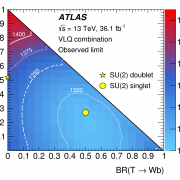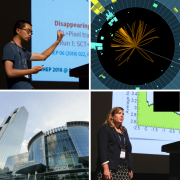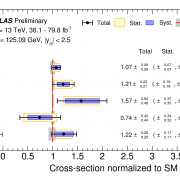Access to Collaboration Site and Physics Results

A new set of techniques is being used to identify highly energetic top quarks, W and Z bosons, and Higgs bosons decaying to quarks and, ultimately, to hadrons measured in ATLAS. Signatures of these “boosted” Standard Model particles are particularly useful when searching for massive new particles and measuring processes at high energies.
This week, at the BOOST conference, ATLAS physicists presented new results identifying boosted objects in Run-1 data and also in early 2015 data at the unprecedented 13 TeV proton–proton collision energy. For W and Z identification, ATLAS performed a comprehensive study of a large number of “tagging” algorithms, establishing which provide the best and most robust “rejection” of hadronic final states arising from quarks and gluons while maintaining a good efficiency for real W and Z bosons. Rejection is measured as 1 divided by the efficiency of selecting quark and gluon jets; a rejection of 50 would mean that, if the tagger is applied, the background rate is diminished by a factor of 50. Figure 1 shows the rejection for 756 tagging algorithms when optimized to select W bosons with an efficiency of 50%, and illustrates that a rejection of about 50 is achievable for a 50% W boson selection efficiency. In addition, ATLAS has measured both the efficiency and rejection rates in 2012 data for the three best algorithms (Figure 2), and found good agreement between the measured data and predictions from the Monte Carlo simulation.

ATLAS is now looking forward to applying boosted particle tagging techniques to the data now being collected at 13 TeV in the search for physics beyond the Standard Model.
A similar study was performed for the tagging of boosted top quarks. Figure 3 shows the background rejection as a function of top tagging efficiency for a variety of top tagging algorithms. ATLAS has also verified the reconstruction of boosted top quarks. In Figure 4, the reconstructed mass is shown, using one example algorithm. Simulation predictions are in good agreement with the data, and over 99% of the decays in the distribution peaking around the top quark mass originate from real top quark decays.

In Run 2 at 13 TeV proton–proton collision energy, the fraction of processes with boosted particles increases. ATLAS prepared for these analyses by studying the taggers in updated simulations and scrutinising the first data. Data have been compared to simulations for several variables used for the tagging of W, Z and Higgs bosons and top quarks in an effort to build confidence in conclusions from simulation-only studies. While no significant amount of new physics signal events are expected yet from the small Run 2 data set collected, it is nonetheless useful to make these comparisons for the main background “multi-jet” production. One such comparison is shown in Figure 5. ATLAS is now looking forward to applying boosted particle tagging techniques to the data now being collected at 13 TeV in the search for physics beyond the Standard Model.










